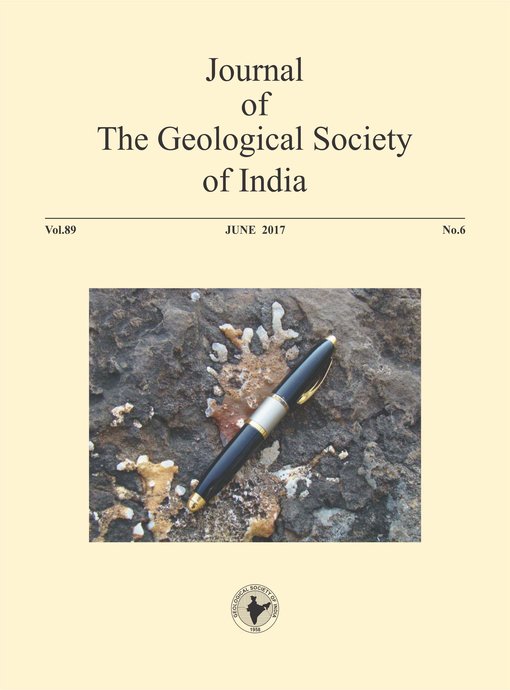Stability Analysis and Remedial Measures of a Landslip at Keifang, Mizoram - A Case Study
DOI:
https://doi.org/10.1007/s12594-017-0681-0Abstract
Landslips are often triggered due to non-engineered excavation of potential unstable slopes. Such slips can be stabilized by implementing suitable remedial measures. A landslip occurred at a drilling site of Oil India Limited in Mizoram State due to slope excavation. There was an immediate concern to protect the slope as the drilling platform and the highway at the top of the slope are at risk if further landslide occurs in future. Slope stability analysis of the failed slope was carried out to design suitable control measures for the protection of the slope from further sliding. Slope stability using various methods indicated that the slope is marginally stable. To improve the stability of the slope, suitable retaining structure at the toe of the slope was suggested and designed. Stability analysis performed with inclusion of retaining wall showed a significant increase in factor of safety of the slope. The suggested remedial measure has been implemented at the site and there is no landslip reported since then. The paper presents the results of the slope stability analysis and the design details of the retaining structure prescribed as the protection measure.Downloads
Metrics
Issue
Section
Downloads
Published
How to Cite
References
Aryal, K.P. (2008) Differences between LE and FE methods used in slope stability evaluations. 12th International Conference of International Association for Computer Methods and Advances in Geomechanics (IACMAG), 1-6 October, 2008, Goa, India.
Bhandari, R.K. (1988) A novel low cost drum diaphragm wall for landslide control in the Himalaya. Second International Conference on Case Histories in Geotechnical Engineering, 1-5 June, 1988, St. Louis, Missouri, pp.333-336.
Bishop, A.W. (1955) The use of the slip circle in the stability analysis of slopes. Geotechnique, v.5, pp.7-17.
Fell, R. (1994) Stabilization of soil and rock slopes. In: Proc. East Asia Symp and Field Workshop on Landslides and Debris Flows, Seoul, Rep. 1, pp.7– 74.
Fellenius, W. (1936) Calculation of stability of earth dam. In transactions of 2nd Congress Large Dams, Washington DC, v.4, pp.445-462.
Garg K.G. (1998) Retaining wall with reinforced backfill - a case study. Geotextiles and Geomembranes, v.16 pp.135-149.
GEO5 (2013) Slope stability geotechnical software, Prague, Czech Republic.
Holtz, R.D. and Schuster, R.L. (1996) Stabioization of soil slopes. In Landslides Investigation and Mitigation, Eds. Turner A.K. and Schuster, R.L., Special Report 247, Transportation Research Board.
Hutchinson, J.N. (1977) The assessment of the effectiveness of corrective measures in relation to geological conditions and types of slope movement. Bull IAEG, no.16, pp.131-155.
IS 1893. (2002) Criteria for earthquake resistant design of structures. Indian Standard, New Delhi.
IS 14680. (1999) Landslide control – Guidelines. Indian Standard, New Delhi.
IS -14458. (1998) Retaining wall for hill area guidelines: Construction of gabion walls.
IS -14458. (1998) Retaining wall for hill area guidelines: Design of RCC cantilever wall/buttressed walls/L-type walls.
Janbu, N. (1957) Earth pressure and bearing capacity calculation by generalized procedure of slices. Proceedings of the Fourth International Conferences on Soil Mechanics and Foundation Engg., London, v.2, pp.207-213.
Mehrotra, G.S., Bhagat, N.C. and Sarkar, S. (1991) Landslide hazards in Garhwal Himalayas, Mussoorie slide – A case study. Proceedings of the Ninth Asian Regional Conference on Soil Mechanics and Foundation Engineering, v.1, 9-13 December, Bangkok, Thailand. pp.409-414.
Morgenstern, N. R. and Price, V.E. (1965) The analysis of the stability of general slip surfaces. Geotechnique, v.17(1), pp.11-26.
Popescu, M.E. (1996) From landslide causes to landslide remediation. Special lecture, In: Proc 7th Int. Symp on Landslides, Trondheim, Rep 1, pp.97–114
Popescu, M.E. (2001) A suggested method for reporting landslide remedial measures. IAEG Bull., v.60(1), pp.69-74.
Sarkar, S., Kanungo, D.P. and Kumar, S. (2012) Rock mass classification and slope stability assessment of road cut slopes in Garhwal Himalaya. Geotechnical and Geological Engineering, v.30(4), pp.827-840.
Schuster, R.L. (1992). Recent advances in slope stabilization. Keynote paper, In: Proc. 6th Int. Symp. on Landslides, Christchurch, Rep 3, pp.1715–1746.
Zaruba, Q. and Mencl, V. (1982) Landslides and their control. Elsevier, Amsterdam, p.324.

 Shantanu Sarkar
Shantanu Sarkar






